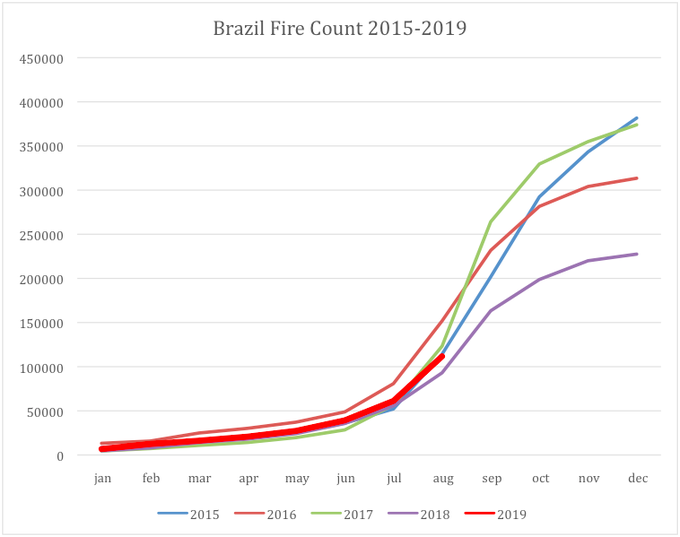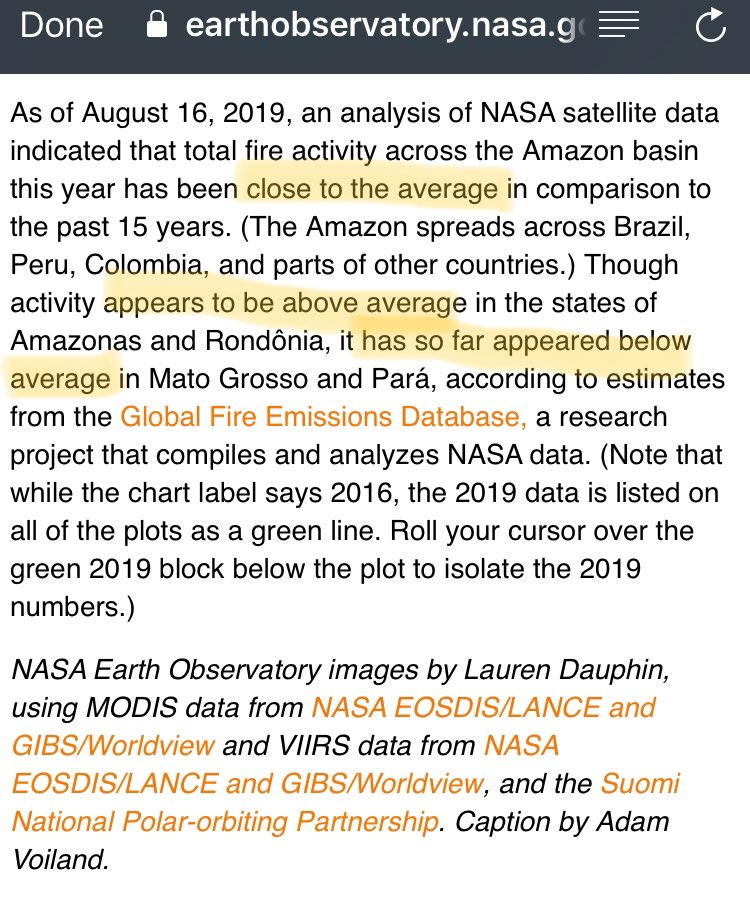All this week, the mainstream media have been trying to scare you with heartrending tales of burning Amazonia — a conflagration the like of which we have never seen before. Supposedly…
A Washington Post story headlined ‘Bolsonaro, Trump, and the nationalists ignoring climate disaster’ quotes Vitor Gomes, an environmental scientist at the Federal University of Para:
“I cannot remember any other big fire episode like this one.”
According to the BBC:
Brazil’s Amazon rainforest has seen a record number of fires this year, new space agency data suggests.
The National Institute for Space Research (Inpe) said its satellite data showed an 84% increase on the same period in 2018.
According to NPR:
Half the fires in Brazil so far this year, nearly 36,000 of them, have ignited in just the past month.
That’s nearly as many as in all of 2018.https://www.npr.org/2019/08/21/753140642/tens-of-thousands-of-fires-ravage-brazilian-amazon-where-deforestation-has-spike …
Tens Of Thousands Of Fires Ravage Brazilian Amazon, Where Deforestation Has Spiked
Researchers say there’s been a huge rise in the number of fires compared with last year. That’s likely linked with a similar leap in deforestation since President Jair Bolsonaro took office.
npr.org
According to this recidivist enviro-loon activist:
From a scientist who specializes in prehistorical fire in the Amazon: The current fires are without precedent in the past 20,000 years.
These fires are not natural, they are being driven by greed, colonialism, and are a crime against humanity.
We are in a climate emergency. https://twitter.com/yoshi_maezumi/status/1164519665374285824 …
Dr S. Yoshi Maezumi@yoshi_maezumiReplying to @gilromera and 9 othersI havent seen anything like this in any of our records at least since the LGM. But the preGlacials not my bag. Too cold
no fire
The fires have spawned a hashtag — #PrayforAmazonia — and attracted the inevitable display of competitive virtue-signalling from the wankerati, with Jennifer Lopez, Madonna, Leonardo DiCaprio, and Kris Jenner among those eagerly expressing their concern on social media.
Politicians have jumped on the bandwagon too:
Our house is burning. Literally. The Amazon rain forest – the lungs which produces 20% of our planet’s oxygen – is on fire. It is an international crisis. Members of the G7 Summit, let’s discuss this emergency first order in two days! #ActForTheAmazon
But almost everything you have read or heard about the Amazon fires in the mainstream media is #FakeNews.
Like so many of the environmental scare stories which grip the world’s media periodically, it is a panic which has been deliberately and cynically stoked by left-leaning eco-activist groups for a number of purposes:
- To generate public hysteria in order to precipitate expensive and unnecessary government action which no sober cost benefit analysis could ever justify
- To raise ‘awareness’ — and, by extension, money — for the green cause
- To discredit conservatives, especially those who are properly sceptical of the green agenda, such as President Trump and his Brazilian counterpart Jair Bolsonaro
- To reinforce in the popular imagination the notion that economic growth and expressions of national sovereignty — in this case the interests of Brazilian farmers — are intrinsically bad for the environment
- To promulgate the common received idea that the Amazon is the ‘lungs of the planet’ and therefore sacrosanct and inviolable in much the same manner as polar bears, glaciers, Pacific islands, the Great Barrier Reef, etc.
- To lend false credibility to the global left’s claim that the planet is experiencing a #ClimateEmergency
- To invoke the spectre of the Green New Deal and, by extension, to rain on the parade of Trump 2020
- To exploit the mainstream media’s insatiable demand for environmental scare stories, especially in the August “silly season” when there’s a shortage of real news
Here is the truth about the Amazon fires:
The fires are mainly on agricultural land – not virgin rain forest…
Turns out the Amazon Rain Forest fires aren’t exactly as advertised.
Read for yourself: fires are mainly in agricultural areas as farmers prepare their land for planting. The land was cleared in the past. https://www.nytimes.com/interactive/2019/08/24/world/americas/amazon-rain-forest-fire-maps.html?smid=tw-nytimes&smtyp=cur …
amazing: an informative article and very informative map by NYT on Amazon fires. Map shows that fires in previously cleared land. Nothing new. Furore is yet another fraud by enviro activists. https://twitter.com/phl43/status/1165341025151389702 …
Philippe Lemoine@phl43This is a good, no non-sense article on the Amazon fires in Brazil. https://www.nytimes.com/interactive/2019/08/24/world/americas/amazon-rain-forest-fire-maps.html …
There is nothing abnormal about this fire season
To everyone concerned about the future of the Amazon: sensationalizing the current fire season in the Amazon will not help keep it from burning.
Monthly Amazon fire count data from NASA in recent years: thick red line is 2019 thru present. https://twitter.com/EricHolthaus/status/1164652546847399937 …Eric Holthaus✔@EricHolthaus
From a scientist who specializes in prehistorical fire in the Amazon: The current fires are without precedent in the past 20,000 years.
These fires are not natural, they are being driven by greed, colonialism, and are a crime against humanity.
We are in a climate emergency. https://twitter.com/yoshi_maezumi/status/1164519665374285824 …

OK: So your page was from here:https://earthobservatory.nasa.gov/images/145464/fires-in-brazil …
(That was not the link *I* provided. But thanks. That’s what I wanted to read. )
I provided this.https://www.earthobservatory.nasa.gov/images/145498/uptick-in-amazon-fire-activity-in-2019 …Uptick in Amazon Fire Activity in 2019
Satellites have detected an increase in fire activity early in the 2019 dry season in the southern Amazon.
earthobservatory.nasa.gov
So, it appears:
* Fire close to average from 2003-2018. (Period of MODIS operation.)
* Fire highest since 2012. Graphs and discussion in that article I linked leave out fires from 2003-2011.Presumably, there were big fires sometimes between 2003-2011.
Even NASA admits this…
good spotting https://twitter.com/scotty_nice/status/1165236343250837505 …
scottynice@scotty_niceReplying to @erikpjverweij and 2 othersNASA data does not reflect NASA opinion, so, don’t believe the data
Also, they most explicitly do not say that
Deforestation is getting better, not worse

Turns out the Amazon Rain Forest fires aren’t exactly as advertised.
Read for yourself: fires are mainly in agricultural areas as farmers prepare their land for planting. The land was cleared in the past. https://www.nytimes.com/interactive/2019/08/24/world/americas/amazon-rain-forest-fire-maps.html?smid=tw-nytimes&smtyp=cur …
Deforestation has decreased markedly compared to the 1990-2005.
Slash and burn land clearing is still an ongoing problem ~2,500 sq miles per year mainly for agriculture.
The Amazon rainforest does NOT produce 20 per cent of the world’s oxygen (h/t Dennis Ambler)
From a 2014 New York Times article by Nadine Unger, Assistant Professor of Atmospheric Chemistry at Yale:
Moreover, it is a myth that photosynthesis controls the amount of oxygen in the atmosphere.
Even if all photosynthesis on the planet were shut down, the atmosphere’s oxygen content would change by less than 1 percent.
The Amazon rain forest is often perceived as the lungs of the planet.
In fact, almost all the oxygen the Amazon produces during the day remains there and is reabsorbed by the forest at night.
In other words, the Amazon rain forest is a closed system that uses all its own oxygen and carbon dioxide.
Using satellite imagery, scientists have discovered the remains of once densely populated towns in west Brazil, an area that was thought to be virgin forest.
The report in Friday’s edition of the journal Science describes clusters of towns and smaller villages that were connected by complex road networks and were arranged around large central plazas. Researches also discovered signs of farming, wetland management and fish farms in the ancient settlements that are now almost completely covered by rainforest.
As Professor Philip Stott, Emeritus Professor BioGeography at the School of Oriental and African Studies, University of London, wrote in 2003:
At the end of the last ice age – some 12,000 to 18,000 years ago – the tropics were covered by seasonal savannah grassland, cooler and much drier than now. There were no rain forests in the Malay Peninsula and much of Amazonia, and, despite the increasing human development of forest space, there are still more rain forests persisting than existed then.
Whatever the world’s greenies say, there is no adamantine rule that Brazil — or its neighbours — must stay rain forested in perpetuity.





















